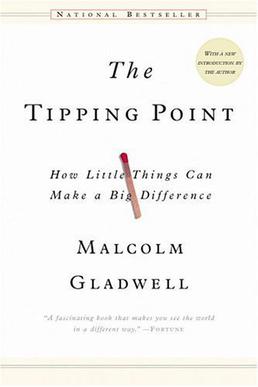Opinion: In The Tipping Point, Quantity does not Equal Quality
 As a part of an effort to prepare students for college and reading beyond high school, Mrs. Gleghorn’s College Writing students have been reading The Tipping Point, a nonfiction novel by Malcolm Gladwell. In The Tipping Point, Gladwell discusses the science, sociology, and psychology behind epidemics and identifies what makes a specific factor a “tipping point” in a fad or trend. Despite the use of scientific studies and sound evidence, Gladwell’s use of anecdotal evidence and other examples can seem to be quite excessive and unnecessary for the point he attempts to convey to readers with his book. Although the findings of Gladwell are valid and valuable to our modern society, the way that Gladwell presents this information seems to be quite ineffective and excessive and only appeals to a very niche audience.
As a part of an effort to prepare students for college and reading beyond high school, Mrs. Gleghorn’s College Writing students have been reading The Tipping Point, a nonfiction novel by Malcolm Gladwell. In The Tipping Point, Gladwell discusses the science, sociology, and psychology behind epidemics and identifies what makes a specific factor a “tipping point” in a fad or trend. Despite the use of scientific studies and sound evidence, Gladwell’s use of anecdotal evidence and other examples can seem to be quite excessive and unnecessary for the point he attempts to convey to readers with his book. Although the findings of Gladwell are valid and valuable to our modern society, the way that Gladwell presents this information seems to be quite ineffective and excessive and only appeals to a very niche audience.
Throughout the work, Gladwell structures his analysis into chapters, dividing each distinguishing factor into its own respective section and examples to accompany. In his exploration of sociology, Gladwell presents three common factors that are consistent throughout every epidemic and trend. In describing these rules, which are the Law of the Few, the Stickiness Factor, and the Power of Context, Gladwell categorizes the defining factors of epidemics. However, though his categorization, the underlying concepts and principles of epidemics are simplified to a fault. The excessive use of anecdotal evidence and lengthy descriptions of each example leave the reader no room to form their own conclusions and opinions regarding the matter. The interest level in these narratives varies from person to person and largely depends on personal preference, but it is truly not necessary to describe each example in such depth. In fact, these vivid descriptions and long-winded sections of text offer litter room for analysis and personal ideas, an area where Gladwell seems to be lacking. The approach to portraying the point that Gladwell tries to make is sound: research does lead to evidence and can easily prove a point one is trying to make. However, without analysis to accompany this research and evidence, the resulting text feels dry and lifeless, just as it did in The Tipping Point.
Despite the excessiveness of Gladwell’s evidence, his anecdotes are extremely relevant in today’s society. In the Afterword, Gladwell briefly discusses the Columbine Effect and the sociological effect of catastrophes, like school shootings, on teenagers. Understanding the power that the Columbine shooters gave to other teenagers and the ritualistic figureheads they represented in teenage society is a comforting feeling. Although knowing this information can be quite disturbing, this knowledge can allow teenagers to practice safety and recognize the warning signs of a catastrophe like a school shooting. This example is an elaboration of teenage smoking, which is an outdated, but still relevant piece of evidence. Throughout the teen smoking epidemic, Gladwell says that it was the “permission-givers” – those teens viewed as cool, extroverted, and worthy of attention – who were responsible for spreading this epidemic. He elaborated that it was not the practice of smoking itself that was cool: it was that people who were cool were often the same people who smoked. This fact is essential in understanding teenage hive mentality and the general behavior of teenagers. Although the information that Gladwell provides in Chapter 7 is especially relevant, the evidence provided throughout the rest of the novel does not hold the same weight and credibility. Their relevance to modern society is not especially high, and even if it is especially relevant to an individual, the information is provided in excess. This overwhelming load of information is the most detrimental factor of the novel overall.
The Tipping Point is a modern exploration of the psychology, sociology, and overall science of epidemics and fads. Although Gladwell makes some solid points throughout his work, his overload of information is excessive. Said overload of information does not allow the reader to form their own conclusions about the subject matter and generally reduces the quality of the information provided. If Gladwell had shortened the material he provided, perhaps he would make a better argument for the point he was trying to prove. The psychology and sociology of the novel was interesting, but was presented in a way that was ineffective, excessive, and generally boring.

Emily Vero is currently a senior at Mohawk Jr./Sr. High School. As a passionate writer, she has been working on The Arrow since her junior high years....






